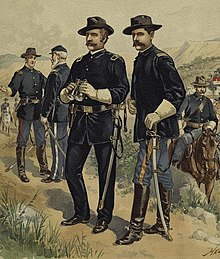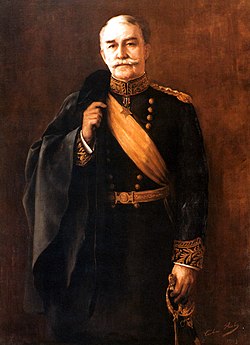Nelson A. Miles
Nelson A. Miles | |
|---|---|
 Miles as Commanding General, 1898 | |
| 1st Military Governor of Puerto Rico | |
| In office July 25, 1898 – October 18, 1898 | |
| President | William McKinley |
| Preceded by | Position established |
| Succeeded by | John R. Brooke |
| Commanding General of the U.S. Army | |
| In office October 5, 1895 – August 8, 1903 | |
| President | Grover Cleveland William McKinley Theodore Roosevelt |
| Preceded by | John Schofield |
| Succeeded by | Position abolished (Samuel B. M. Young as Chief of Staff of the U.S. Army) |
| Personal details | |
| Born | August 8, 1839 Westminster, Massachusetts, U.S. |
| Died | May 15, 1925 (aged 85) Washington, D.C., U.S. |
| Resting place | Arlington National Cemetery |
| Political party | Republican |
| Alma mater | Taylor University |
| Awards | Medal of Honor |
| Signature | |
| Military service | |
| Allegiance | United States |
| Branch/service | United States Army |
| Years of service | 1861–1903 |
| Rank | Lieutenant General |
| Unit |
|
| Commands |
|
| Battles/wars | |
Nelson Appleton Miles (August 8, 1839 – May 15, 1925) was a United States Army officer who served in the American Civil War, the American Indian Wars and the Spanish–American War. From 1895 to 1903, Miles served as the last Commanding General of the United States Army, before the office was transformed into the Chief of Staff of the Army.
Early life
Miles was born in Westminster, Massachusetts, on his family's farm. He worked in Boston, read military history, and mastered military principles and techniques, including battle drills. He attended Fort Wayne College.
Civil War

Miles was working as a crockery store clerk in
Other battles he participated in include
Indian Wars

In July 1866, Miles was appointed a colonel in the Regular Army.
Miles played a leading role in nearly all of the

In December 1880, Miles was promoted to brigadier general in the Regular Army. He was then assigned to command the
In April 1890, Miles was promoted to major-general in the Regular Army and became the commander of the Military Division of the Missouri. The Ghost Dance movement of the Lakota people, which started in 1889, led to the Pine Ridge Campaign and Miles being brought back into the field. During the campaign, he commanded U.S. Army troops stationed near Indian reservations in South Dakota and hoped that Lakota chief Sitting Bull could be peacefully removed from the Standing Rock Indian Reservation. However, on December 15, Bull was killed by Indian agency police attempting to arrest him, and 14 days later American troops massacred hundreds of Lakota at Wounded Knee. Miles was not directly involved in the massacre, and was critical of the commanding officer in the field, James W. Forsyth. Just two days after the massacre, Miles wrote to his wife, describing it as "the most abominable criminal military blunder and a horrible massacre of women and children".[9] After his retirement from the army, he fought for compensation payments to the survivors of the massacre. Overall, he believed that the United States should have authority over the Indians, with the Lakota under military control.
Spanish–American War and later life

In his capacity as commander of the
After the surrender of

To show that he was still physically able to command, on July 14, 1903, less than a month before his 64th birthday, General Miles rode the 90 miles from Fort Sill to Fort Reno, Oklahoma, in eight hours' riding time (10 hrs 20 mins total), in temperatures between 90 and 100 °F (32 and 38 °C). The distance was covered on a relay of horses stationed at 10-mile intervals; the first 30 miles were covered in 2 hours, 25 minutes. This was the longest horseback ride ever made by a commanding general of the army.[13]
Called a "brave peacock" by President Theodore Roosevelt,[citation needed] Miles nevertheless retired from the army in 1903 upon reaching the mandatory retirement age of 64. Upon his retirement, the office of Commanding General of the United States Army was abolished by an Act of Congress and the Army Chief of Staff system was introduced. A year later, standing as a presidential candidate at the Democratic National Convention, he received a handful of votes.[citation needed] The Prohibition Party was going to give him their nomination, but an hour before balloting he sent a telegram to the convention stating that he did not want the nomination which went to Silas C. Swallow instead.[14] When the United States entered World War I in 1917, the 77-year-old general offered to serve, but President Woodrow Wilson turned him down.[citation needed]
Miles died in 1925 at the age of 85 from a
Military awards

- Medal of Honor
- Civil War Campaign Medal
- Indian Campaign Medal
- Spanish Campaign Medal
- Army of Puerto Rican Occupation Medal
Medal of Honor citation

Rank and Organization:
- Colonel, 61st New York Infantry. Place and date: At Chancellorsville, Va., May 3, 1863. Entered service at: Roxbury, Mass. Birth: Westminster, Mass. Date of issue: July 23, 1892.
Citation:
- Distinguished gallantry while holding with his command an advanced position against repeated assaults by a strong force of the enemy; was severely wounded.[17]
Memberships
General Miles was a member of several hereditary and military societies, including the
Legacy

Miles City, Montana is named in his honor,[18] as is Miles Street and the Miles Neighborhood in Tucson, Arizona. Miles Canyon on the Yukon River near Whitehorse, Yukon, was named after him in 1883 by Lt. Frederick Schwatka during his exploration of the river system. A steamship, General Miles, was likely named for him. Nelson M. Holderman, himself a Medal of Honor recipient, was also named after Miles. Fort Miles at Cape Henlopen near Lewes, Delaware, was named for Miles 3 June, 1941. See Wikipedia article on Fort Miles.
Miles' legacy as an Indian fighter has seen him portrayed by
Dates of rank
| Insignia | Rank | Component | Date |
|---|---|---|---|
| First Lieutenant | 22nd Massachusetts Infantry |
9 September 1861 | |
| Lieutenant Colonel | 61st New York Infantry | 31 May 1862 | |
| Colonel | 61st New York Infantry | 30 September 1862 | |
| Brigadier General | Volunteers | 12 May 1864 | |
| Brevet Major General | Volunteers | 25 August 1864 | |
| Major General | Volunteers | 21 October 1865 | |
| Colonel | 40th Infantry, Regular Army | 28 July 1866 | |
| Brevet Major General | Regular Army | 2 March 1867 | |
| Colonel | 5th Infantry, Regular Army | 15 March 1869 | |
| Brigadier General | Regular Army | 15 December 1880 | |
| Major General | Regular Army | 5 April 1890 | |
| Lieutenant General | Regular Army | 6 June 1900 | |
| Lieutenant General | Retired List | 8 August 1903 |
See also
- List of Medal of Honor recipients
- List of American Civil War Medal of Honor recipients: M–P
- List of American Civil War generals (Union)
- List of Massachusetts generals in the American Civil War
Notes
- ^ Eicher, p. 389.
- ^ U.S. Senate (1887). Journal of the Executive Proceedings of the Senate of the United States. Vol. XV, Part I. Washington, D.C.: U.S. Government Printing Office. p. 42 – via Google Books.
- ^ Smithsonian Online Virtual Archives. "Historical Note: The Bureau of Refugees, Freedmen, and Abandoned Lands". Records of the Assistant Commissioner for the State of North Carolina Bureau of Refugees, Freedmen, and Abandoned Lands, 1865–1870. Washington, DC: Smithsonian Institution. Retrieved July 27, 2022.
- ISBN 0803297750.
- Newspapers.com.
- ^ "Signal Service Station on Mount Hood". Daily Alta California. September 20, 1884. Retrieved April 21, 2013.
- ^ Reade, Lt. Philip (January 1880). "About Heliographs". The United Service. 2: 91–108. Retrieved June 21, 2011.
- ^ ISBN 0-89950-736-0
- ISBN 9780873385947.
- ^ The Encyclopedia of the Spanish-American and Philippine-American Wars: A Political, Social, and Military History, Volume 1, p. 400
- ^ "Invasion of Puerto Rico". The Goldfields Morning Chronicle (Coolgardie, WA : 1896—1898). July 19, 1898. Retrieved October 29, 2019.
- JSTOR 1984406.
- ^ See newspaper reports from Washington, D.C. (Showing off his Stamina. General Miles making 90-mile horseback ride) and Kansas City, MO (General Miles made it in Triumph), July 14, 1903. Hot off the Press Long Riders Guild Academic Foundation. Retrieved October 11, 2015.
- Newspapers.com.
- ^ "Gen. Nelson A. Miles Diesat Circus; Indian Fighter, 85, Falls Lifeless While Viewing Pageant, with Mrs. Coolidge Near by. Civil War "Boy General" Won Congressional Medal – Fought Also in Spanish-American War – of Family of Soldiers". The New York Times.
- ^ Warner, pp. 323–324, states that Miles was the "last survivor of the full rank major generals of Civil War vintage" and of all general officers, was outlasted only by John R. Brooke (died 1926) and Adelbert Ames (died 1933).
- ^ "MILES, NELSON A., Civil War Medal of Honor recipient". American Civil War website. November 8, 2007. Retrieved November 8, 2007.
- ^ Gannett, Henry (1905). The Origin of Certain Place Names in the United States. U.S. Government Printing Office. p. 208.
- ^ Heitman, Francis B. (1903). Historical Register and Dictionary of the United States Army, 1789–1903, Vol. 1. Washington, DC: Government Printing Office. pp. 708–709.
References
- DeMontravel, Peter R. A Hero to His Fighting Men, Nelson A. Miles, 1839–1925. Kent, OH: The Kent State University Press, 1998. ISBN 0-87338-594-2.
- Eicher, John H., and ISBN 0-8047-3641-3.
- Miles, Nelson Appleton. Personal Recollections and Observations of General Nelson A. Miles. Chicago: Werner Co., 1896. OCLC 84296302.
- Warner, Ezra J. Generals in Blue: Lives of the Union Commanders. Baton Rouge: Louisiana State University Press, 1964. ISBN 0-8071-0822-7.
- Greene, Jerome. American Carnage: Wounded Knee, 1890. University of Oklahoma Press, 2014. ISBN 978-0806144481
Further reading
- Freidel, Frank. The Splendid Little War. Short Hills, NJ: Burford Books, 1958. ISBN 0-7394-2342-8.
- Greene, Jerome A. Yellowstone Command: Colonel Nelson A. Miles and the Great Sioux War, 1876–1877. Norman: University of Oklahoma Press, 2006, 1991. ISBN 080613755X
External links
- Works by Nelson Appleton Miles at Project Gutenberg
- Works by or about Nelson A. Miles at Internet Archive
- Commanding Generals and Chiefs of Staff Archived May 5, 2017, at the Wayback Machine
- Nelson A. Miles Collection Archived May 7, 2013, at the Wayback Machine US Army Heritage and Education Center, Carlisle, Pennsylvania
- David Leighton, "Tucson Street Smarts: Miles Street named for famed general," Arizona Daily Star, March 19, 2013
- Guide to the Nelson Appleton Miles Collection 1886 at the University of Chicago Special Collections Research Center


